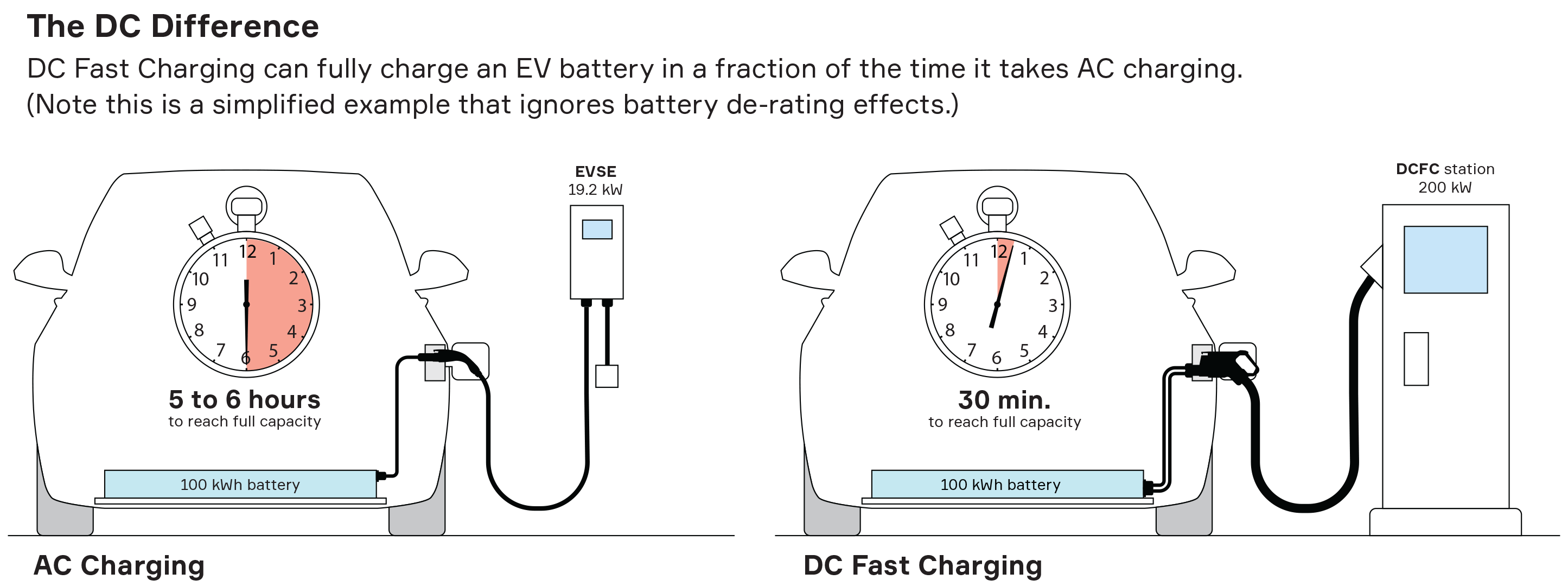What Is DC Fast Charging?
As consumers look to purchase electric vehicles, the amount of time it takes to charge an EV continues to influence their buying decisions. The fastest way to charge an EV today is high-power direct current (DC) fast charging. DC fast charging differs from alternating current (AC) charging, and it requires specific considerations for OEMs when it comes to designing key components of a vehicle’s electrical architecture, such as charging inlets.
Slower charging options (AC Level 1 and AC Level 2) use AC, which is how electricity is typically delivered from the power grid in general, and it is how power is delivered to homes. AC charging rates can range from 12A to 80A, per the SAE J1772 standard in North America, while charging rates elsewhere vary based on regional standards, such as IEC 62196 or GB/T 20234. When EV owners charge their vehicles at home, they plug an EV charger into the vehicle’s charging inlet, and the EV’s onboard charger then converts that AC power to DC to charge the battery.
DC fast charging is the most common method of charging at commercial public charging stations. The stations convert AC power from the grid to DC power so that when a driver plugs in their EV, DC current flows directly to its battery. There are two levels for DC fast charging per the J1772 standard: DC Level 1 for charging rates up to 80A, and DC Level 2 (commonly referred to as Level 3 charging) for rates up to 500A.
The time difference between AC charging and DC fast charging is dramatic. The power output for AC Level 1 charging at 12A and 120VAC could be up to 1.4 kW, while AC Level 2 charging at 80A and 240V offers up to 19.2 kW. Theoretically, it would take about five to six hours to fully charge a 100 kWh battery pack, even using the highest power level of AC charging at 19.2 kW. In contrast, with DC fast charging at 500A and 400VDC, it would theoretically take the same 100 kWh battery about 30 minutes to reach full capacity. These charging times will decrease further with advancements in battery technology, upgrades to 800V architecture, and improvements in charging infrastructure.
Considerations
There are several factors that can affect the rate of DC fast charging, such as the following:
- Battery pack limitations: Every EV battery has a specific acceptance rate, measured in kilowatts, reflecting how quickly it can store electrical energy. For example, if a DC fast charger is rated at 150 kW but the vehicle’s battery can only accept up to 100 kW, then it will certainly take longer to charge. The acceptance rate of the battery can vary depending on several factors, including battery chemistry, design, size and age. Many OEMs are looking to upgrade their battery pack architecture from 400V to 800V to maximize acceptance rates and reduce charging durations.
- Temperature: Extreme ambient temperatures, both hot and cold, can reduce the charging rate or even prevent the battery from accepting a charge altogether.
- State of charge: In general, the acceptance rate of an EV battery is highest when the battery is at a low state of charge (SoC) and decreases as the battery gets closer to its maximum SoC. Most EVs follow a defined current profile whereby the charging rate slows significantly as the vehicle approaches a full charge, particularly once it reaches 80 percent, to reduce the risk of overcharging and damaging the battery.
- Charging infrastructure limitations: Most DC fast charging stations in the market today have maximum charge rates of about 200A to 300A. While the number of 500A DC fast charging stations is growing, they are expensive and complicated to install.
- Heat generation: Because of its high current, DC fast charging generates heat throughout the EV charging system — from the EV charger to the inlet, and from the high-voltage cables to the battery connections and the battery itself — and that heat must be managed. Standards such as J1772 and IEC 62196 specify a maximum operating temperature limit of 90° C at the interface between the charger and the inlet to ensure touch-safe conditions for consumers operating the device. If the temperature approaches that limit, the charging rate will have to be decreased, so managing and monitoring that interface is key for charging performance.
For OEMs, the challenge is to provide a charging inlet that is flexible enough to accommodate both AC charging and DC fast charging options across regions, is able to detect and dissipate heat, and is built with a service-friendly design.
Aptiv’s modular charging inlets are equipped with advanced temperature-sensing technology that can accurately track temperatures and relay that information to the system in real time. The inlets can use passive-cooling systems leveraging busbars, or active-cooling systems than run liquid coolant to a cold plate near the terminals or to the busbars adjacent to the pins to draw heat away.
Aptiv works closely with OEMs to address their pain points, designing state-of-the-art charging inlets and charging harnesses that meet their requirements for charging speed, cooling, physical orientation and flexibility across regions — all with Aptiv’s full-system perspective and global reach, ensuring compatibility with DC fast charging stations located around the world.